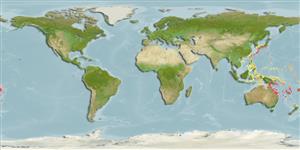Actinopterygii (peixes com raios nas barbatanas) >
Perciformes (Perch-likes) >
Blenniidae (Combtooth blennies) > Blenniinae
Etymology: Petroscirtes: Latin, petra, -ae = stone + Greek, skirteo = to jump.
Ambiente / Clima / Intervalo
Ecologia
; marinhas; estuarina bentopelágico; intervalo de profundidade 1 - 10 m (Ref. 86942). Subtropical, preferred ?
Western Pacific: Queensland, New South Wales, Lord Howe Island, Australia and New Caledonia.
Tamanho / Peso / Idade
Maturity: Lm ? range ? - ? cm
Max length : 13.0 cm TL macho/indeterminado; (Ref. 2334)
Espinhos dorsais (total): 11; Raios dorsais (total): 19-20; Espinhos anais 2; Raios anais : 18 - 20. Jaw teeth incisiform, rigid, close-set, increasing with age; large, curved canine tooth on each side at posterior of lower jaw, and smaller canine on each side at posterior of upper jaw (similar dentition shared within genera); lower end of gill opening above level of pectoral-fin base (also a shared character within genera); small unbranched cirrus on each side of chin; with or without small supraorbital and nuchal cirri; body depth at anal-fin origin 4.5-7.0 SL; males with elongated second dorsal spine; unnotched dorsal fin; caudal fin interradial membranes slightly incised, notably in males; ground color variable with habitat, gray, brown, or green, with 6 large, uneven dark blotches on upper side and numerous white dots and dashes and, ventrally, dark dots. Anal soft rays rarely 18; pectoral soft rays typically 14; segmented caudal rays 1, unbranched (Ref. 54980).
Adults hide in seagrasses, seaweeds, or empty mollusk shells. Oviparous (Ref. 205). Mature females lay eggs on the inner surface of dead bivalve shells which are guarded by the male (Ref. 2334). Larvae are planktonic, often found in shallow, coastal waters (Ref. 94114).
Life cycle and mating behavior
Maturidade | Reprodução | Desova | Ovos | Fecundidade | Larvas
Oviparous, distinct pairing (Ref. 205).
Randall, J.E., G.R. Allen and R.C. Steene, 1990. Fishes of the Great Barrier Reef and Coral Sea. University of Hawaii Press, Honolulu, Hawaii. 506 p. (Ref. 2334)
Status na Lista Vermelha da IUCN (Ref. 115185)
CITES (Ref. 94142)
Not Evaluated
Perigo para os humanos
Harmless
Uso pelos humanos
Mais informação
ReferênciasAquaculturaPerfil para aquaculturaEstirpesGenéticaFrequência alélicaHereditariedadeDoençasProcessamentoMass conversion
ColaboradoresFotosStamps, CoinsSonsCiguateraVelocidadeTipo de nataçãoÁrea branquialOtólitosCérebrosVisão
Ferramentas
Relatórios especiais
Baixar XML
Fontes da internet
